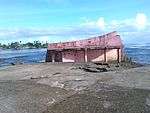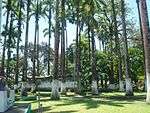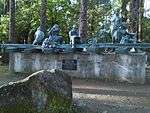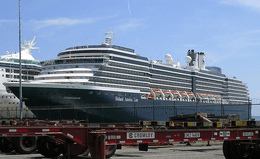Limón
| Puerto Limón | ||||||||
|---|---|---|---|---|---|---|---|---|
| City and municipality | ||||||||
Images, from top down, left to right: Panoramic view of Limón, Vargas Park, Playa Bonita, Historic Building of the Baptist Reverend Heath, Onlook of 2nd Avenue, the MS Zuiderdam docked at Limón's Port terminal. | ||||||||
| ||||||||
|
Motto: Paz y Trabajo (Spanish) "Peace and Work" | ||||||||
 Puerto Limón and surrounding area | ||||||||
 Puerto Limón Location of Puerto Limón within Costa Rica | ||||||||
| Coordinates: 9°59′N 83°02′W / 9.983°N 83.033°WCoordinates: 9°59′N 83°02′W / 9.983°N 83.033°W | ||||||||
| Country |
| |||||||
| Province | Limón | |||||||
| Founded | 1870 | |||||||
| Government | ||||||||
| • Mayor | Néstor Mattis Williams | |||||||
| Area | ||||||||
| • Total | 59.79 km2 (23.09 sq mi) | |||||||
| Elevation | 0 m (0 ft) | |||||||
| Population (2012)[1] | ||||||||
| • Total | 58,522 | |||||||
| Demonym(s) | limonense | |||||||
| Time zone | CST (UTC-6) | |||||||
| • Summer (DST) | None (UTC-6) | |||||||
| Postal code | 70101 | |||||||
Puerto Limón (Spanish pronunciation: [ˈpweɾto liˈmon]), commonly known as Limón (Spanish for "lemon"),[2] is the capital city and main hub of Limón province, as well as of the cantón (county) of Limón in Costa Rica. It is the sixth-largest city in Costa Rica, with a population of over 55,000 (including surrounding towns), and is home of a multicultural community.[3] Part of the community traces its roots to Italian, Jamaican and Chinese laborers who worked on a late nineteenth-century railroad project that connected San José to Puerto Limón. Until 1948, the Costa Rican government did not recognize Afro-Caribbean people as citizens and restricted their movement outside Limón province.[4] As a result of this "travel ban", this Afro-Caribbean population became firmly established in the region, which influenced the decision to not move even after it was legally permitted. Nowadays, there is an important outflow of Limón natives who move to the country's Central Valley in search for better employment and education.[5] The Afro-Caribbean community speaks Spanish and Limonese Creole, a creole of English.
Puerto Limón contains two port terminals, Limón and Moín, which permit the shipment of Costa Rican exports as well as the anchoring of cruise ships. Health care is provided for the city by Hospital Dr. Tony Facio Castro.[6] Two small islands, Uvita Island and Isla de Pájaros, are just offshore.
History
Colonization
Christopher Columbus first dropped anchor in Costa Rica in 1502 at Isla Uvita, just off the coast of Puerto Limón. The Atlantic coast, however, was left largely unexplored by Spanish settlers until the 19th century.
As early as 1569, Governor Perafán de Rivera gave extensive plots of land, Indians included, in Matina to aristocrats (hidalgos) that helped to finance and support early conquest. Because these aristocrats found out that only a few Indians were available to exploit, they had no choice but to acquire black slaves to plant these lands with cocoa trees (the only feasible crop in these lands). These lands provided the only source of income to the absentee owners from the capital city of Cartago. Matina gained importance because of the cacao and the presence of black slaves, which made them attractive to pirate incursions.
Notorious pirates, Edward Mansvelt and his vice admiral Henry Morgan, arrived at Portete, a small bay between Limón and Moín, in 1666. They proceeded inland to Cartago, the capital of Costa Rica at the time, but were driven away by the inhabitants at Turrialba on 15 April. The pirate army left on 16 April and arrived back in Portete on 23 April. They left Costa Rica and did not return.[7]
Founding
The town was officially founded in 1854 by Philipp J. J. Valentini under government auspices.[8] In 1867, construction began on an ambitious railroad connecting the highlands to the sea. Limón was chosen as the site of a major port, which would facilitate exports of the coffee from the Central Valley.[9]
Afro-Costa Rican
The first African people who arrived in Costa Rica came with the Spanish conquistadors. Slave trade was common in all the countries conquered by Spain, and in Costa Rica the first Africans seem to have come from specific sources in Africa- Equatorial and Western regions. The people from these areas were thought of as ideal slaves because they had a reputation for being more robust, affable and hard-working than other Africans. The enslaved were from what is now the Gambia (Mandingas), Guinea (specifically Wolofe), Ghanaian (Ashanti), Benin (specifically Ije / Ararás) and Sudan (Puras).[1] Many of the enslaved were also Minas (i.e. communities from parts of the region extending from Ivory Coast to the Slave Coast), Popo (be imported tribes as Ana and Baribas), Yorubas and Congas (perhaps from Kongasso, Ivory Coast).[2] Eslaved Africans also came from other places, such as neighboring Panama. Throughout the centuries, but especially after the emancipation of the slaves in 1824, the black population mixed with other ethnic groups, notably the Indians, and became part of the mainstream culture and ethnicity.
The early black population of Matina and Suerre in Limón is not the same population that arrived in the second half of the XIXth Century. This latter population did not arrive as slaves but as hired workers from Jamaica, and smaller groups from Barbados and Trinidad and Tobago. This is the reason why the majority of the current black population of Costa Rica has English surnames and speak English with a Jamaican accent.
In 1910, Marcus Mosiah Garvey travelled to Puerto Limón, where he worked as a time-keeper for the United Fruit Company for some months, observing that the population of African descent suffered poor conditions.[10]
The descendant of Africans in Costa Rica have endured discrimination including a delay in voting rights and a restriction on their movements.
Recent History
Puerto Limon was struck by the 1991 Limon earthquake, which affected the surrounding landscape and coastline.
Demographics
Most Afro-Costa Ricans are found in Limón Province.[6]
Districts
Limón is divided into four districts which are in turn subdivided into pueblos and poblados (neighbourhoods and villages).[11]
| Limón Canton | ||
| Districts (Distritos) | Neighbourhoods (Pueblos) | Villages (Poblados) |
| 1. Limón | Bellavista, Bohío, Bosque, Cangrejos, Cariari, Cerro Mocho, Cielo Amarillo, Cristóbal Colón o Cieneguita, Corales (1, 2 and 3), Cruce, Fortín, Hospital, Laureles, Limóncito, Moín, Piuta, Portete, Pueblo Nuevo, Roosevelt, San Juan, Santa Eduviges, Trinidad, Veracruz, Colina, Ceibón, Pacuare, Siglo XXI | Buenos Aires, Cocal, Dos Bocas, Empalme Moin, Milla Nueve, Santa Rosa |
| 2. Valle La Estrella | Alsacia, Armenia, Atalanta, Boca Río Estrella, Bocuare, Bonifacio, Buenavista, Burrico, Calveri, Casa Amarilla, Cerere, Colonia, Concepciòn, Cuen, Chirripó Abajo, Duruy, Fortuna, Guaria, Hueco, I Griega, Loras, Miramar, Nanabre, Nubes, Penshurt, Pleyades, Provenir, Progreso, Río Ley, Río Seco, San Andrés, San Carlos, San Clemente, San Rafael, Talía, Tobruk, Tuba Creek, Valle Las Rosas, Vesta | |
| 3. Río Blanco | Liverpool | Brisas, Búfalo, México, Milla 9, Miravalles, Río Blanco, Río Cedro, Río Madre, Río Quito, Sandoval, Santa Rita, Victoria |
| 4. Matama | Bomba | Aguas Zarcas, Asuncióm, Bananito Norte, Bananito Sur, Bearesem, Beverley, Calle Tranvía, Castillo Nuevo, Dondonia, Filadelfia Norte, Filadelfia Sur, Kent, Manú, María Luisa, Mountain Cow, Polonia, Quitaría, Tigre, Trébol, Wesfalia |
Celebrations
Puerto Limón is famous in Costa Rica for its yearly fall festival called carnaval which occurs the week of 12 October, the date Columbus first anchored off Limón's coast in 1502, on his fourth voyage. The event was started by local community leader and activist, Alfred Josiah Henry Smith (known as "Mister King"), who helped organize the first carnaval in October 1949.[12] The event stretches about a week (across two weekends), and includes a parade, food, music, dancing, and, on the last night, a concert in the Parque Vargas headlined by a major Latino or Caribbean music act. Previous artists have included Eddy Herrera (2002), Damian Marley (2003), El Gran Combo de Puerto Rico (2005), and T.O.K. (2006).
Although the show goes on rain or shine, the event has recently suffered some setbacks. Organizers cancelled carnaval in 2007 due to a major dengue outbreak,[13] and again in 2008 due to major municipal trash-removal issues and related health worries.[9] While trash removal had long been an issue due to lack of trucks and a 62-mile haul to the nearest landfill (in Pococí), the ordered closure of this and other landfills in 2007 meant Puerto Limón had to send trash 135 miles to Alajuela and pay a higher disposal fee.[14][15][16] The situation led to a bottle-neck in trash removal, which, combined with the major dengue breakout, caused organizers to cancel 2008's carnaval as a precautionary measure.[9] Given the severity of the situation, the city bought land in nearby Santa Rosa and, in April 2009, opened its own landfill (called El Tomatal).[16] Given the improved situation, carnaval picked up in 2009 after its two-year hiatus.
Climate
Limón features a tropical rainforest climate under Köppen’s climate classification. Average temperatures are relatively consistent throughout the year averaging around 25 degrees Celsius. Common to all cities with this climate, Limón has no discernible dry season. Its driest month (September) averages roughly 160 mm of precipitation while the wettest month (December) averages just above 400 mm of rain. Limon averages nearly 3,400 mm of precipitation annually.
| Climate data for Limón International Airport, Costa Rica | |||||||||||||
|---|---|---|---|---|---|---|---|---|---|---|---|---|---|
| Month | Jan | Feb | Mar | Apr | May | Jun | Jul | Aug | Sep | Oct | Nov | Dec | Year |
| Record high °C (°F) | 32.9 (91.2) |
33.4 (92.1) |
33.9 (93) |
34.5 (94.1) |
35.0 (95) |
35.0 (95) |
33.7 (92.7) |
34.3 (93.7) |
33.8 (92.8) |
34.4 (93.9) |
34.5 (94.1) |
33.0 (91.4) |
35.0 (95) |
| Average high °C (°F) | 28.8 (83.8) |
29.1 (84.4) |
29.7 (85.5) |
30.1 (86.2) |
30.4 (86.7) |
30.3 (86.5) |
29.6 (85.3) |
30.1 (86.2) |
30.6 (87.1) |
30.4 (86.7) |
29.4 (84.9) |
28.9 (84) |
29.8 (85.6) |
| Daily mean °C (°F) | 24.8 (76.6) |
24.9 (76.8) |
25.5 (77.9) |
26.1 (79) |
26.6 (79.9) |
26.6 (79.9) |
26.1 (79) |
26.3 (79.3) |
26.6 (79.9) |
26.4 (79.5) |
25.7 (78.3) |
25.1 (77.2) |
25.9 (78.6) |
| Average low °C (°F) | 20.7 (69.3) |
20.7 (69.3) |
21.2 (70.2) |
22.0 (71.6) |
22.8 (73) |
22.9 (73.2) |
22.6 (72.7) |
22.5 (72.5) |
22.5 (72.5) |
22.3 (72.1) |
21.9 (71.4) |
21.2 (70.2) |
21.9 (71.4) |
| Record low °C (°F) | 12.9 (55.2) |
16.4 (61.5) |
15.2 (59.4) |
17.4 (63.3) |
17.8 (64) |
20.0 (68) |
16.6 (61.9) |
19.0 (66.2) |
18.9 (66) |
19.2 (66.6) |
15.8 (60.4) |
13.2 (55.8) |
12.9 (55.2) |
| Average precipitation mm (inches) | 319.7 (12.587) |
237.3 (9.343) |
208.5 (8.209) |
263.0 (10.354) |
333.5 (13.13) |
289.0 (11.378) |
426.3 (16.783) |
303.2 (11.937) |
142.1 (5.594) |
207.1 (8.154) |
400.6 (15.772) |
445.0 (17.52) |
3,567.2 (140.441) |
| Average precipitation days (≥ 1.0 mm) | 17 | 14 | 14 | 14 | 16 | 16 | 20 | 16 | 11 | 13 | 17 | 18 | 186 |
| Average relative humidity (%) | 87 | 86 | 85 | 85 | 87 | 87 | 89 | 87 | 86 | 87 | 88 | 88 | 87 |
| Mean monthly sunshine hours | 155.0 | 152.6 | 179.8 | 171.0 | 164.3 | 135.0 | 117.8 | 145.7 | 159.0 | 164.3 | 135.0 | 142.6 | 1,822.1 |
| Mean daily sunshine hours | 5.0 | 5.4 | 5.8 | 5.7 | 5.3 | 4.5 | 3.8 | 4.7 | 5.3 | 5.3 | 4.5 | 4.6 | 5.0 |
| Source #1: Instituto Meteorologico Nacional (precipitation 1941–2012, temperatures 1970–2012, sun 1969–2012, humidity 1970–2012)[17] | |||||||||||||
| Source #2: Meteo Climat (extremes, 1941–present)[18] | |||||||||||||
Transport
Airport
Limón is served by the Pablo Zidar International Airport (Spanish: Aeropuerto Internacional Pablo Zidar, Limón), IATA code LIO, an airstrip which is 1,800m long by 30m wide, 2m above sea level, on the coast south of the city.[19] The Presidency Ministry announced in June 2011 that Sansa Airlines would begin regular scheduled flights four times a week to Limón Airport, beginning in July and costing ₡30,000–₡75,000 ($60–$150), to increase tourism to Limón Province.[20][21][22]
Sports
The city's football team is Limón F.C., after a local business man took over the franchise of Limonense. They play their home games at the Estadio Juan Gobán.
Notable people
Sister city
Gallery
 View from the Balvanero Vargas Park
View from the Balvanero Vargas Park The old amphitheater, circa 2004
The old amphitheater, circa 2004 The amphitheater in 2015, signs of heavy damage and abandonment are evident
The amphitheater in 2015, signs of heavy damage and abandonment are evident Inside the Balvanero Vargas Park
Inside the Balvanero Vargas Park- The Black Star Line building before its destruction by fire in 2016
 The remains of the Black Star Line building
The remains of the Black Star Line building The Post Office building in October 2015
The Post Office building in October 2015 The pavilion at the Balvanero Vargas park
The pavilion at the Balvanero Vargas park Monument to the Development and Ethnic Diversity
Monument to the Development and Ethnic Diversity Municipal Market during the start of its restoration
Municipal Market during the start of its restoration The cathedral. Its bell tower is the tallest building in the city
The cathedral. Its bell tower is the tallest building in the city
References
- ↑ "World Gazetteer". Archived from the original on 17 Feb 2013.
- ↑ limón Span¡shD!ct. Retrieved: 11 June 2011.
- ↑ Censo Nacional de oblación. Características Sociales y Demográficas, 2002
- ↑ The History of Costa Rica
- ↑ What Happen: A Folk-History of Costa Rica's Talamanca Coast
- 1 2 "Quienes Somos: Hospital Regional Dr. Tony Facio Castro" Caja Costarricense de Seguro Social. Retrieved: 2012-03-07. (Spanish)
- ↑ Crónicas Coloniales Ricardo Fernández Guardia, 1921. portlimon.com.
- ↑ Encyclopedia Americana (1918–1920), Vol. XXVII, p. 645-646 online version at Internet Archive (last viewed 24 May 2011)
- 1 2 3 Crisis por basura obliga a suspender carnavales
- ↑ Marcus Garvey in Port Limon portlimon.com.
- ↑ Mr. Limón.com – Todo sobre Limón (in Spanish)
- ↑ Limón despidió a su Mister King con respeto y carnaval
- ↑ Dengue obliga a cancelar los carnavales de Limón
- ↑ Barrios de Limón siguen repletos de basura
- ↑ Inició recolección de 360 toneladas de basura en calles limonenses
- 1 2 Nuevo relleno sanitario recibirá y tratará la basura del Caribe
- ↑ "Descripción del clima: Cantón de Limón" (in Spanish). Instituto Meteorologico Nacional. Archived from the original on 30 October 2016. Retrieved 30 October 2016.
- ↑ "Station Puerto Limon" (in French). Meteo Climat. Retrieved 6 November 2016.
- ↑ Limón Airport at Great Circle Mapper
- ↑ New flights to Limón seek to drive up tourism The Tico Times, 14 June 2011.
- ↑ Turismo podrá volar a Limón a partir de julio La Nación, 15 June 2011.
- ↑ Airport photographs
External links
 Media related to Limón at Wikimedia Commons
Media related to Limón at Wikimedia Commons Puerto Limón travel guide from Wikivoyage
Puerto Limón travel guide from Wikivoyage




